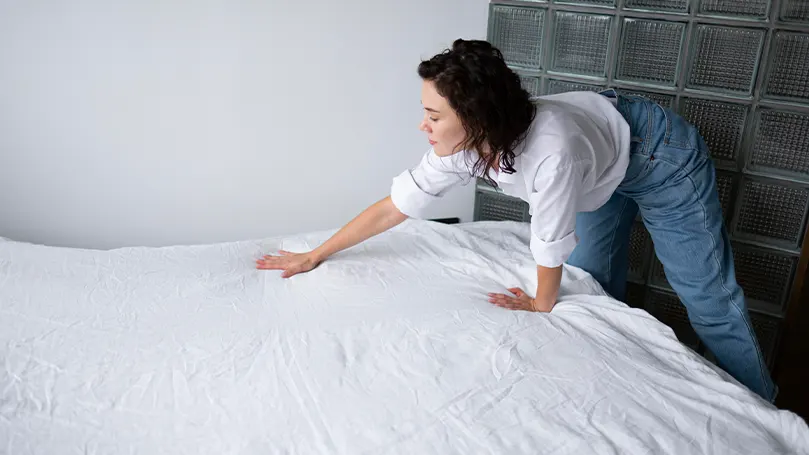What you'll need

In order to protect your duvet from external influences and premature damage:
- Get a suitable cover for it – since you are here, reading this article, you probably already know what a duvet cover is.
- When buying, pay attention to the material, dimensions (especially to duvet cover opening), and manufacturer. You will determine the dimensions after purchasing the duvet or the one you already own.
- Consider other features of the product, such as how it is closed. You will need a flat surface to place the duvet on, preferably your bed.
You can use two methods to make the process quick and easy. It is important to do each step correctly so that the filling is evenly distributed and so as not to damage the products.
Step-by-step guide
You can opt for the California/burrito or the traditional method. You can also do everything yourself or with a partner. In any case, the process involves four basic steps.
1. Lay the duvet cover out
The first rule is to turn the duvet cover inside out. Without this, the method would not make sense. However, placing it on a flat surface and checking the corners of the duvet is equally important. The surface should not be too high or too low for you to complete each subsequent step successfully.
2. Place the duvet inside the cover
The next step includes a duvet. You will place it inside the cover so that it is in line with it. This means that the corners of the duvet must lean against each other. Thanks to this position, you can perform the entire procedure yourself. After you have ensured that the duvet is laid correctly, you can continue.
3. Zip or button up the cover
It is crucial to fasten these two elements additionally, otherwise, the whole process will be in vain. Always check that you have tied it tight enough, so you don't have to repeat the process several times.
4. Shake out and arrange the cover

Once it is completely rolled and you turned the duvet cover, you can close it, take the top corners and give it another shake. Do this several times, if necessary, until the surface is perfectly flat. It is a sign that everything is in its place. If the duvet is smaller than the cover, you may have to repeat this process every morning. However, there is a difference between the materials. Pay attention to this factor as well.
Techniques for putting on a duvet cover
To be sure which method works best for you, try both. To begin with, focus on the key steps you need to take to get the right effect.
Burrito (California) method duvet
The California method is otherwise called the burrito method for obvious reasons. It would be best to turn the blanket inside out and lay it flat over the bed. The end must be closed and on one side of the bed. Next, you will take the duvet and place it flat on top. Check if any corrections need to be made before you start rolling. It should be parallel to the corners of the cover. After you've made sure, everything is in order, stand on the side where the closed end is and start rolling everything together into a sausage shape. Finally, turn the opening towards you and complete the process. Lift the cover and shake it.
Traditional method duvet

The name “traditional method” arose because of its wide use. It is a simple procedure you can do without help, even if your duvet is huge. Lay the duvet flat on the bed and turn the cover inside out. Please do this in a standing position, grab two corners of the blanket, pull them towards you, and turn them inside out. Do not release the corners, but quickly turn them, so the duvet fits into the cover. All that's left is to shake it out and pull on the rest of the cover to level the bedding. Now you can close it.
Duvet cover tricks and tips
One of the most common doubts is whether or not to tie it. It all depends on the type of duvet. If it is a duvet with ties, you can tie it to protect it from moving around the inside cover. Another potential problem could be the size of the duvet. If it is a shade smaller than the protective part, it is necessary to shake it every morning to level it. An exception is the silk duvet because this material is very slippery. In that case, ties are the ideal solution.
Conclusion
If you want to save time and energy, ask someone to help you. You could use an extra pair of hands. In that case, you don't have to stick strictly to one method. Place the duvet on the bed so it stands a bit higher towards the headboard. Have everyone stand on opposite sides of the bed, facing each other.
At the same time, grasp the cover and lay it down with the opening facing the head end. Then, put the lower part of the duvet on the cover. Pull it while holding the corner up, and slide the cover with the other hand. If the corner of the duvet is aligned with the corner of the cover, you've done a good job. You can shake out the duvet and cover, then pin both ends together until they meet in the middle. If there is a zipper enclosure, only one person should do it.
Spread the word
Related products:
Recommended reading:
"*" indicates required fields













Thanks a lot!